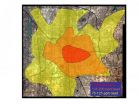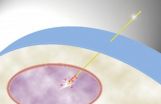(Press-News.org) While the U.S. has made great progress in the prevention and treatment of tuberculosis, the nation has become more susceptible to potential epidemics of multidrug-resistant tuberculosis (MDR-TB), according a study led by Johns Hopkins researchers. Computer simulations show that as TB prevalence falls, the risk for more extensive MDR-TB increases. In addition, the simulation also showed that higher detection of TB cases without proper treatment of cases also increased risk. The study findings are published in the September 22 edition of the journal PLoS ONE. An interactive TB computer simulation used by the research team is available at mdr.tbtools.org.
MDR-TB is a form of tuberculosis that is resistant to at least two of the primary antibiotics used to treat the disease. The World Health Organization estimates that MDR-TB affects between 0.5 and 2 million people each year worldwide, but there were only 111 cases reported in the U.S. in 2006.
For the analysis, the researchers developed a computer model to simulate the potential for MDR-TB epidemics. Eighty-one scenarios covering a 500-year period were created with varying levels of treatment quality, diagnosis accuracy, microbial fitness and the degree of immunogenicity of drug-susceptible TB.
According to the study, when 75 percent of active TB cases are detected, improving therapeutic compliance from 50 percent to 75 percent can reduce the probability of an epidemic from 45 percent to 15 percent. Paradoxically, improving the case-detection rate from 50 percent to 75 percent when compliance with directly observed treatment is constant at 75 percent increases the probability of MDR-TB epidemics from 3 percent to 45 percent.
"The ability of MDR-TB to spread depends on the prevalence of drug-susceptible TB," said David Bishai, MD, PhD, MPH, senior author of the study and associate professor in the departments of Population, Family and Reproductive Health and International Health at the Johns Hopkins Bloomberg School of Public Health. "The most successful approach to reduce this risk for MDR-TB epidemics in the U.S. would be to ensure that populations around the world combine high rates of case findings that are tightly coupled to high compliance with directly observed drug therapy."
INFORMATION:
The authors of "Heightened Vulnerability to MDR-TB Epidemics after Controlling Drug-Susceptible TB" include Jason D. Bishai, an undergraduate student at Stanford University and William R. Bishai, MD, PHD, professor with the Johns Hopkins School of Medicine and co-director of the Johns Hopkins Center for Tuberculosis Research.
The research was funded in part by an award to Jason Bishai from the Robert Wood Johnson Foundation Young Epidemiology Scholars Contest and by NIH grant 5R01AI079590-03.
Computer model shows US vulnerable to MDR-TB epidemic
Low prevalence of TB increases risk for spread of multidrug-resistant TB
2010-09-28
ELSE PRESS RELEASES FROM THIS DATE:
Study shows patient-specific vaccines for metastatic melanoma may induce durable complete regression
2010-09-28
Newport Beach, CA – September 27, 2010 – Hoag Memorial Hospital Presbyterian recently announced encouraging clinical study results for patient-specific vaccine therapy to treat metastatic melanoma. The study is ongoing, but the report concludes that patient-specific vaccines can sometimes induce durable complete regression of progressing soft-tissue melanoma metastases, as demonstrated in one particular patient who participated in the trial.
The study report, entitled: "Durable Complete Response of Refractory, Progressing, Metastatic Melanoma after Treatment with a ...
Diving deeper into the gene pool
2010-09-28
About ten years ago, the discovery of microRNAs ― tiny cellular molecules that regulate our genetic code ― unlocked a world of scientific possibilities, including a deeper understanding of human disease. One new analytical technology is "deep sequencing," which gives scientists the ability to discover invaluable information about human diseases at a genetic level. Now, Tel Aviv University researchers have developed the cutting-edge technology to better analyze these results.
The software, called miRNAkey, was developed by Roy Ronen as part of a team of researchers ...
Elevated nitrogen and phosphorus still widespread in much of the nation's streams and groundwater
2010-09-28
Elevated concentrations of nitrogen and phosphorus, nutrients that can negatively impact aquatic ecosystems and human health, have remained the same or increased in many streams and aquifers across the Nation since the early 1990's, according to a new national study by the U.S. Geological Survey.
"This USGS report provides the most comprehensive national-scale assessment to date of nitrogen and phosphorus in our streams and groundwater," said Marcia McNutt, USGS Director. "For years we have known that these same nutrients in high concentrations have resulted in 'dead ...
Tile drainage directly related to nitrate loss
2010-09-28
URBANA – Tile drainage in the Mississippi Basin is one of the great advances of the 19th and 20th centuries, allowing highly productive agriculture in what was once land too wet to farm. In fact, installation of new tile systems continues every year, because it leads to increased crop yields. But a recent study shows that the most heavily tile-drained areas of North America are also the largest contributing source of nitrate to the Gulf of Mexico, leading to seasonal hypoxia. In the summer of 2010 this dead zone in the Gulf spanned over 7,000 square miles.
Scientists ...
Urban gardeners beware: There may be lead in your soil and food
2010-09-28
INDIANAPOLIS – Not since victory gardens helped World War II era Americans on the home front survive food shortages have urban gardens been as necessary and popular as they are today. With more food production in cities, the safety of the produce grown there becomes increasingly important.
As city dwellers across the country are harvesting fruits and vegetables for family consumption and planning ahead for the next planting season, geochemist Gabriel Filippelli, Ph.D., professor of earth sciences at the School of Science at Indiana University-Purdue University Indianapolis, ...
A shot to the heart: Nanoneedle delivers quantum dots to cell nucleus
2010-09-28
CHAMPAIGN, Ill. — Getting an inside look at the center of a cell can be as easy as a needle prick, thanks to University of Illinois researchers who have developed a tiny needle to deliver a shot right to a cell's nucleus.
Understanding the processes inside the nucleus of a cell, which houses DNA and is the site for transcribing genes, could lead to greater comprehension of genetics and the factors that regulate expression. Scientists have used proteins or dyes to track activity in the nucleus, but those can be large and tend to be sensitive to light, making them hard ...
Study: Electric cars hold greater promise for reducing emissions and lowering US oil imports
2010-09-28
Electric cars hold greater promise for reducing emissions and lowering U.S. oil imports than a national renewable portfolio standard, according to research conducted by Rice University's Baker Institute for Public Policy.
This assessment is among several contained in a new major policy study the Baker Institute Energy Forum will release at a Sept. 27-28 conference titled "Energy Market Consequences of an Emerging U.S. Carbon Management Policy." The study comprises several academic working papers on a variety of topics, such as carbon pricing, the wind industry, global ...
How injured nerves grow themselves back
2010-09-28
Unlike nerves of the spinal cord, the peripheral nerves that connect our limbs and organs to the central nervous system have an astonishing ability to regenerate themselves after injury. Now, a new report in the October 1st issue of Cell, a Cell Press publication, offers new insight into how that healing process works.
"We know a lot about how various cell types differentiate during development, but after a serious injury like an amputation, nerves must re-grow," said Allison Lloyd of University College London. "They need a new mechanism to do that because the developmental ...
Rain or shine, Sandia researchers find new ways to forecast large photovoltaic power plant output
2010-09-28
ALBUQUERQUE, N.M. – Sandia National Laboratories researchers have developed a new system to monitor how clouds affect large-scale solar photovoltaic (PV) power plants. By observing cloud shape, size and movement, the system provides a way for utility companies to predict and prepare for fluctuations in power output due to changes in weather. The resulting models will provide utility companies with valuable data to assess potential power plant locations, ramp rates and power output.
Sandia researchers' work is currently focused at the 1.2-megawatt La Ola Solar Farm on ...
New guideline finds no evidence for a popular back procedure
2010-09-28
Rosemont, Ill. – As a patient safety best practice and endorsement of evidence-based medicine, the American Academy of Orthopaedic Surgeons (AAOS) Board of Directors approved and released a clinical practice guideline, which found a strong recommendation against a popular procedure called vertebroplasty as a way to treat fractures in the spine. Clinical practice guidelines are one avenue the Academy uses to ensure that patients receive high quality care.
Vertebroplasty is a surgical procedure developed to reduce or eliminate the pain associated with compression fractures ...
LAST 30 PRESS RELEASES:
Tracing the quick synthesis of an industrially important catalyst
New software sheds light on cancer’s hidden genetic networks
UT Health San Antonio awarded $3 million in CPRIT grants to bolster cancer research and prevention efforts in South Texas
Third symposium spotlights global challenge of new contaminants in China’s fight against pollution
From straw to soil harmony: International team reveals how biochar supercharges carbon-smart farming
Myeloma: How AI is redrawing the map of cancer care
Manhattan E. Charurat, Ph.D., MHS invested as the Homer and Martha Gudelsky Distinguished Professor in Medicine at the University of Maryland School of Medicine
Insilico Medicine’s Pharma.AI Q4 Winter Launch Recap: Revolutionizing drug discovery with cutting-edge AI innovations, accelerating the path to pharmaceutical superintelligence
Nanoplastics have diet-dependent impacts on digestive system health
Brain neuron death occurs throughout life and increases with age, a natural human protein drug may halt neuron death in Alzheimer’s disease
SPIE and CLP announce the recipients of the 2025 Advanced Photonics Young Innovator Award
Lessons from the Caldor Fire’s Christmas Valley ‘Miracle’
Ant societies rose by trading individual protection for collective power
Research reveals how ancient viral DNA shapes early embryonic development
A molecular gatekeeper that controls protein synthesis
New ‘cloaking device’ concept to shield sensitive tech from magnetic fields
Researchers show impact of mountain building and climate change on alpine biodiversity
Study models the transition from Neanderthals to modern humans in Europe
University of Phoenix College of Doctoral Studies releases white paper on AI-driven skilling to reduce burnout and restore worker autonomy
AIs fail at the game of visual “telephone”
The levers for a sustainable food system
Potential changes in US homelessness by ending federal support for housing first programs
Vulnerability of large language models to prompt injection when providing medical advice
Researchers develop new system for high-energy-density, long-life, multi-electron transfer bromine-based flow batteries
Ending federal support for housing first programs could increase U.S. homelessness by 5% in one year, new JAMA study finds
New research uncovers molecular ‘safety switch’ shielding cancers from immune attack
Bacteria resisting viral infection can still sink carbon to ocean floor
Younger biological age may increase depression risk in older women during COVID-19
Bharat Innovates 2026 National Basecamp Showcases India’s Most Promising Deep-Tech Ventures
Here’s what determines whether your income level rises or falls
[Press-News.org] Computer model shows US vulnerable to MDR-TB epidemicLow prevalence of TB increases risk for spread of multidrug-resistant TB


